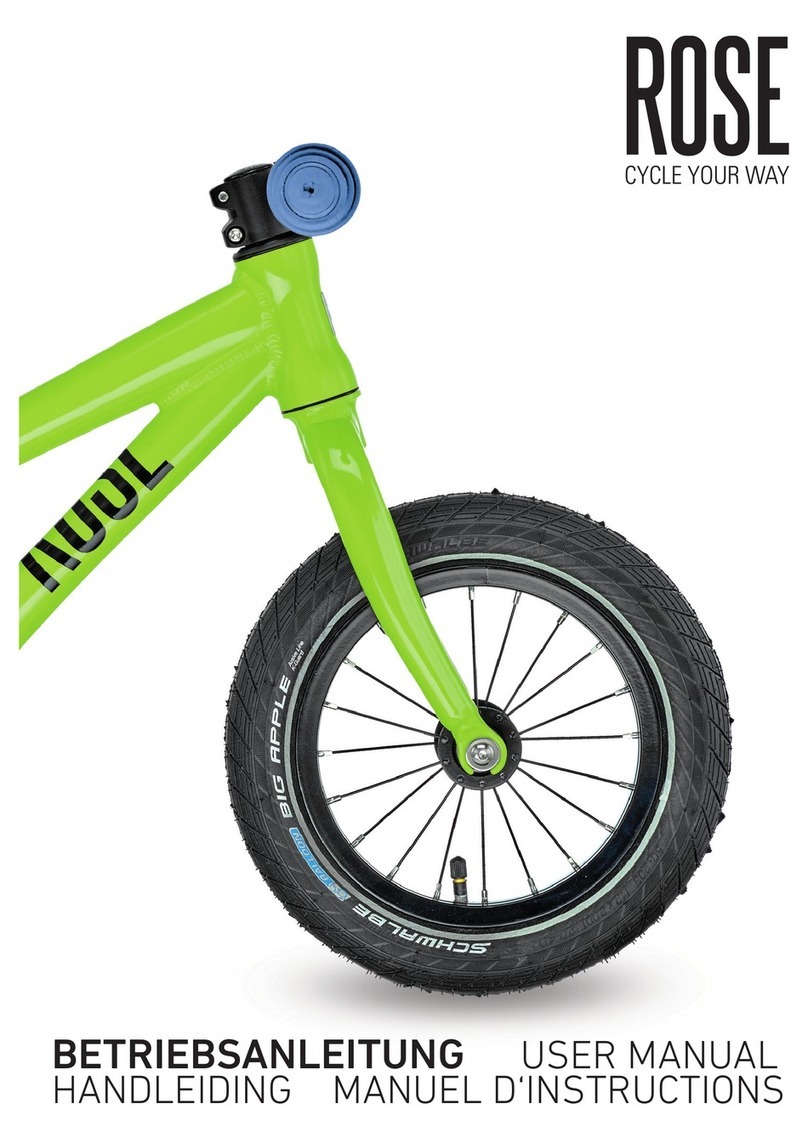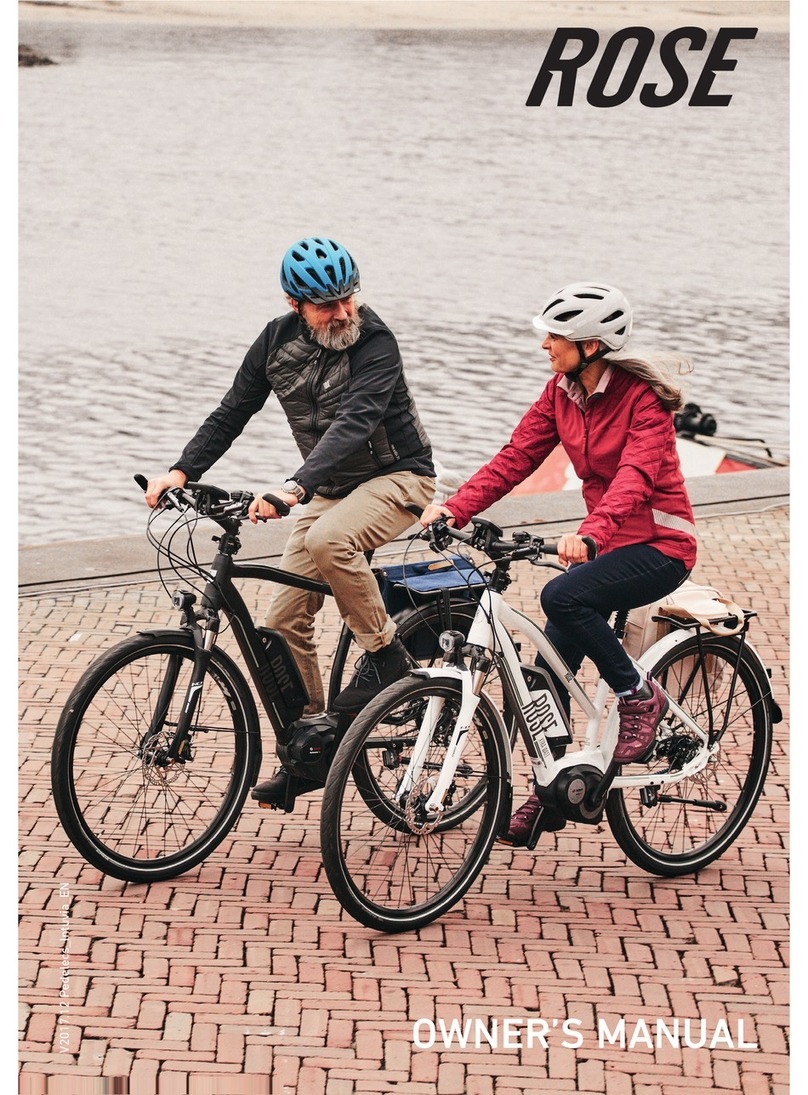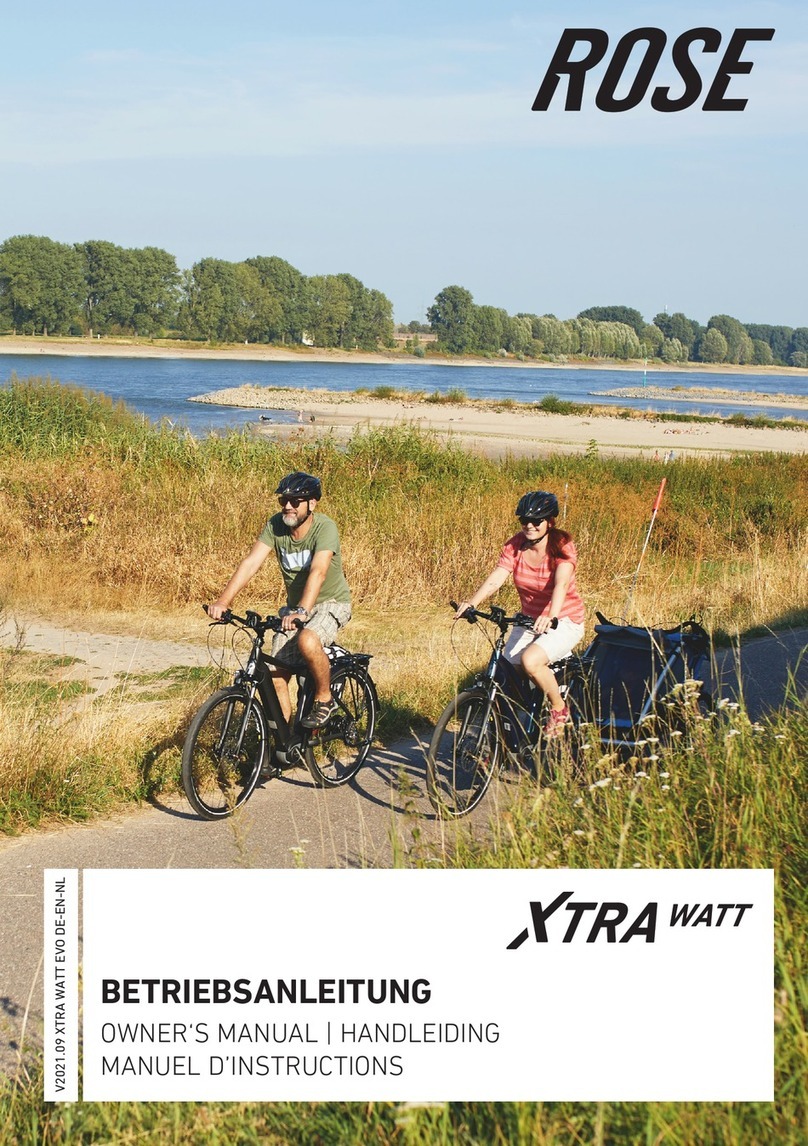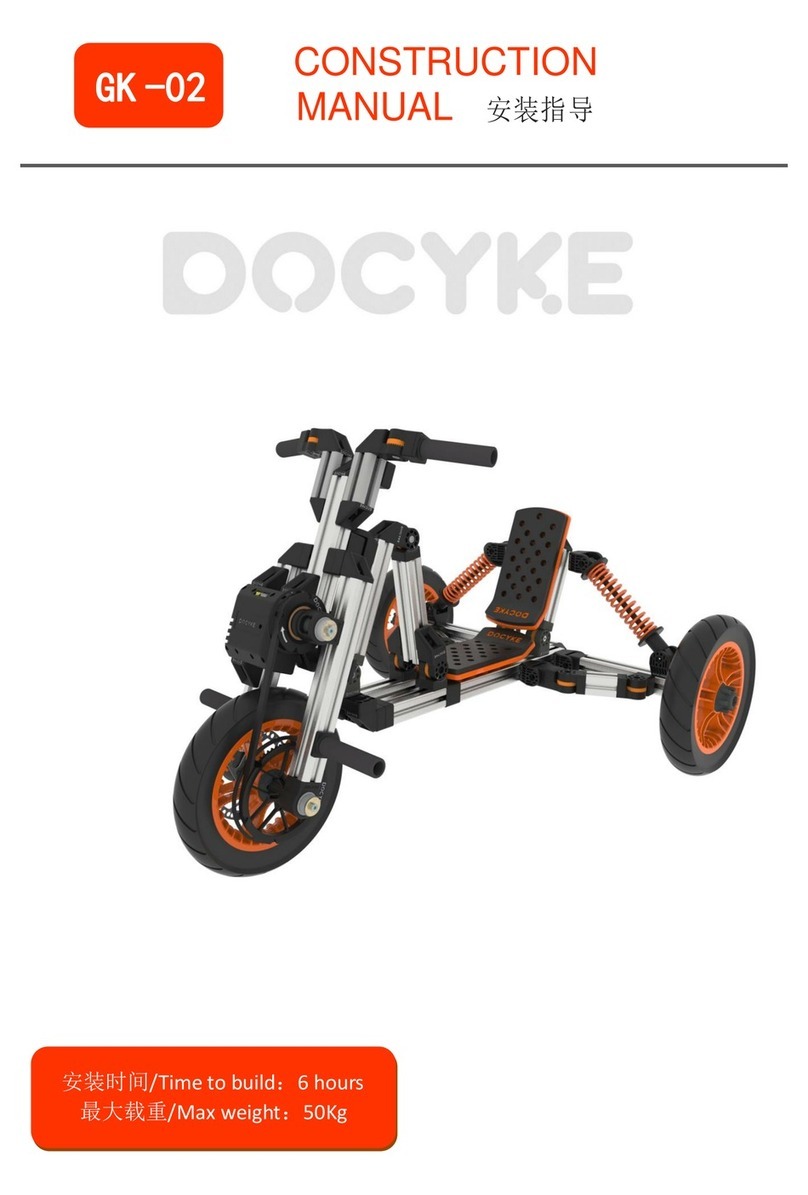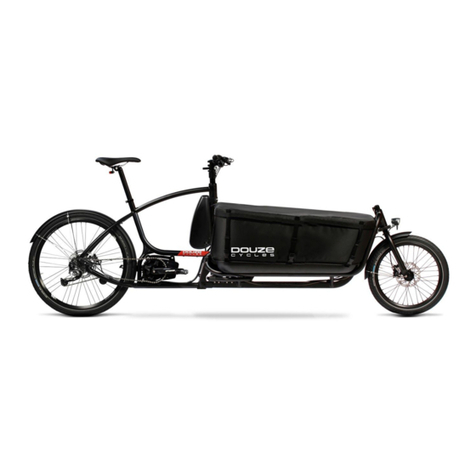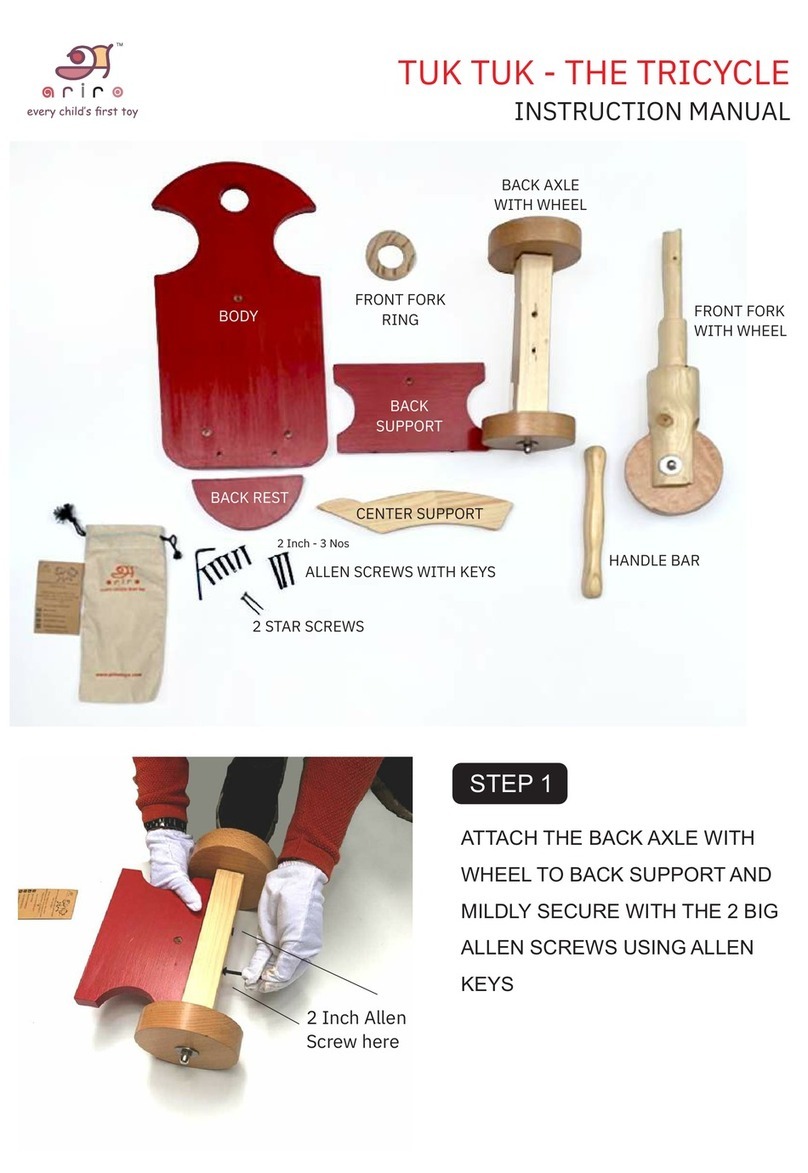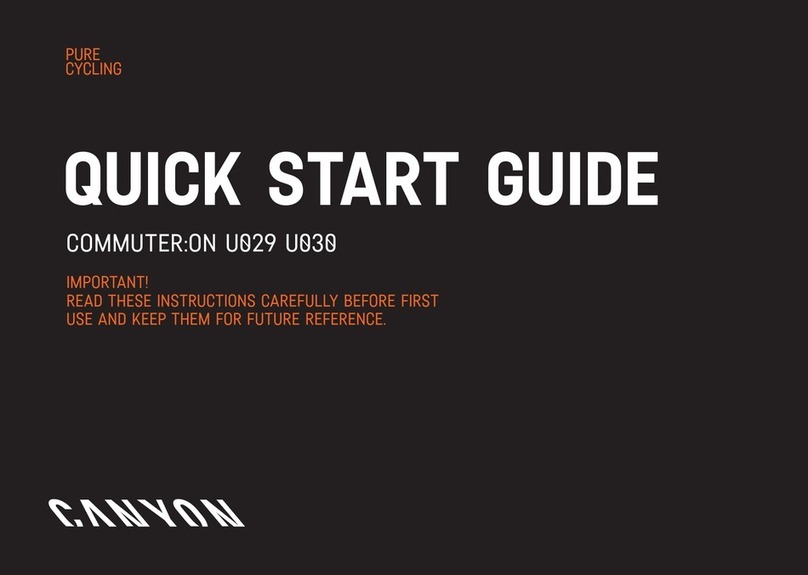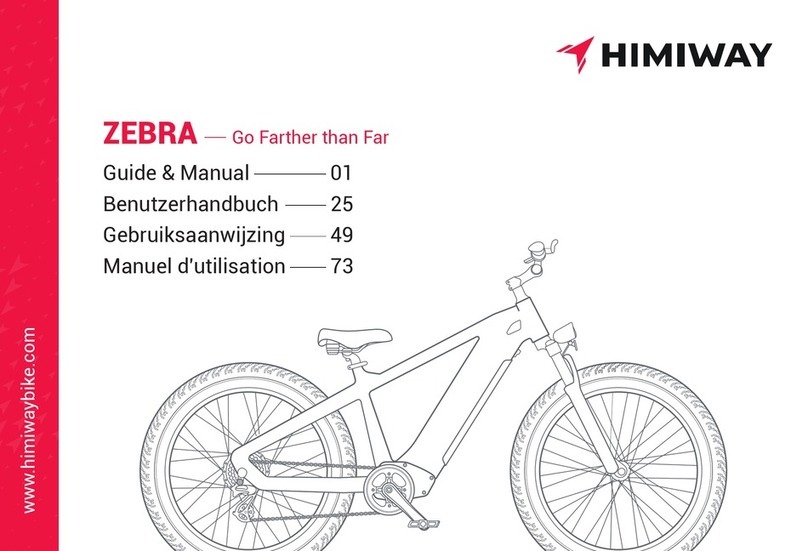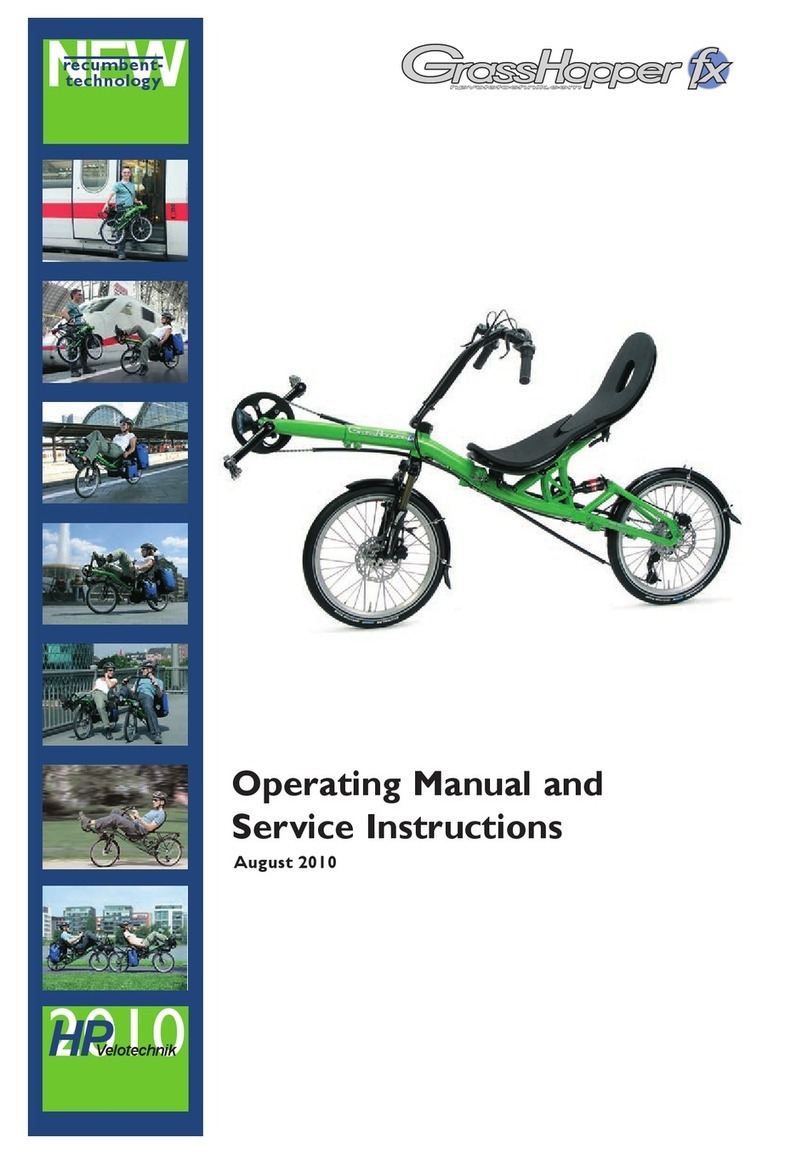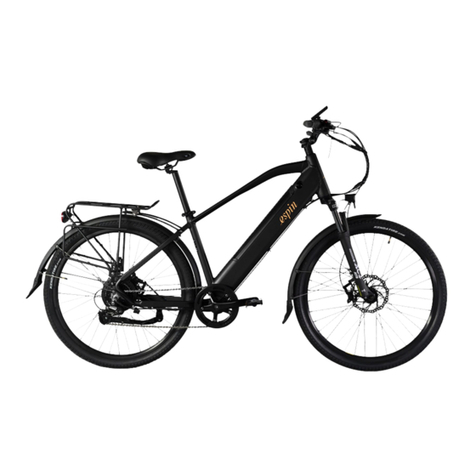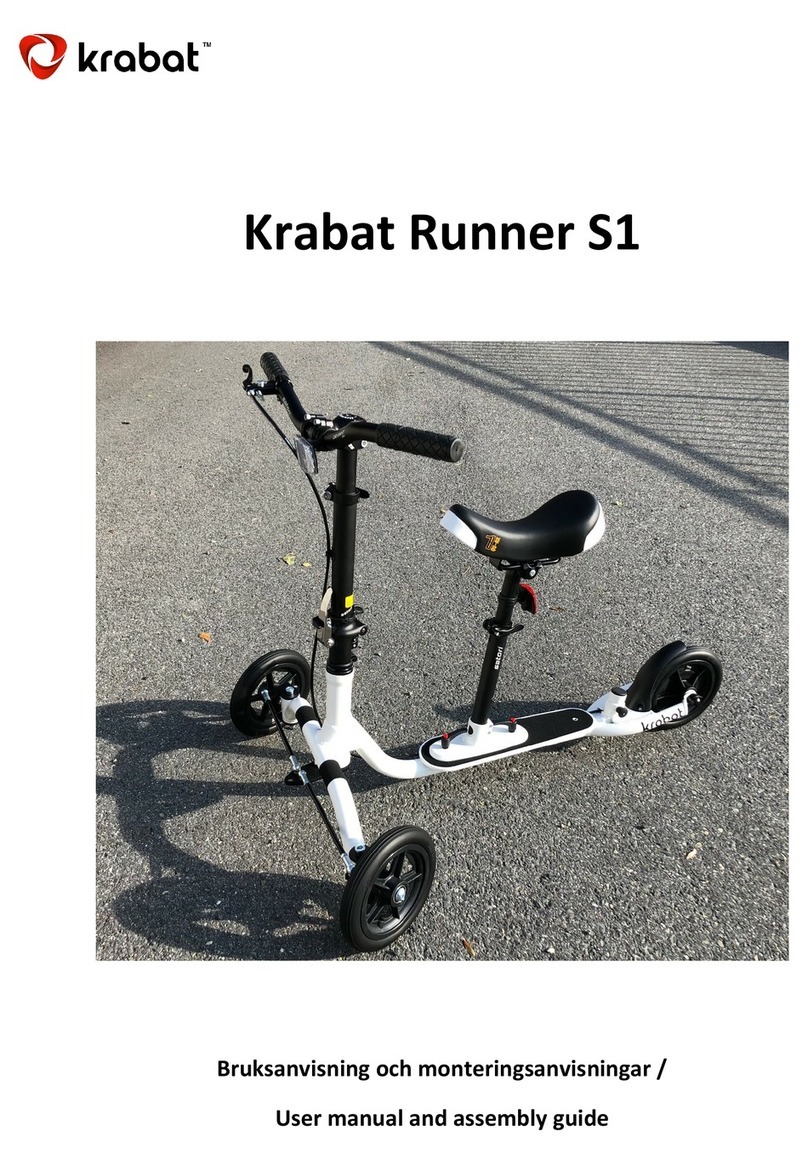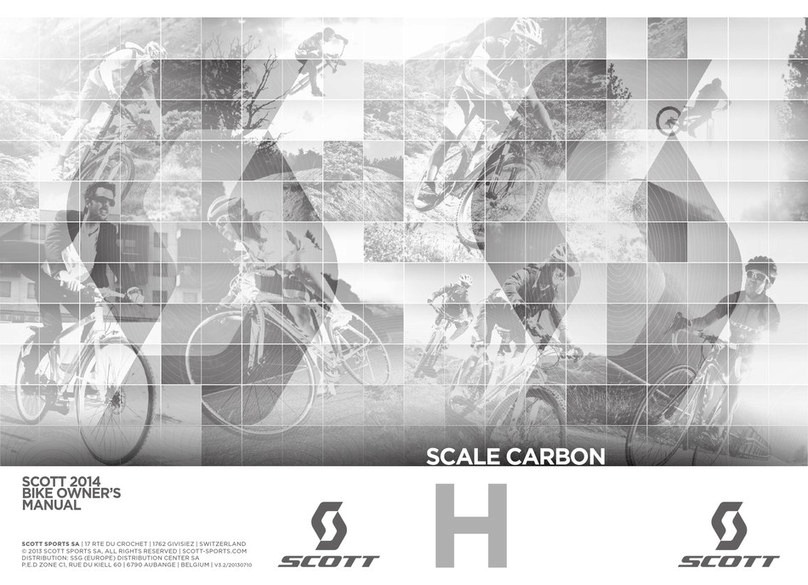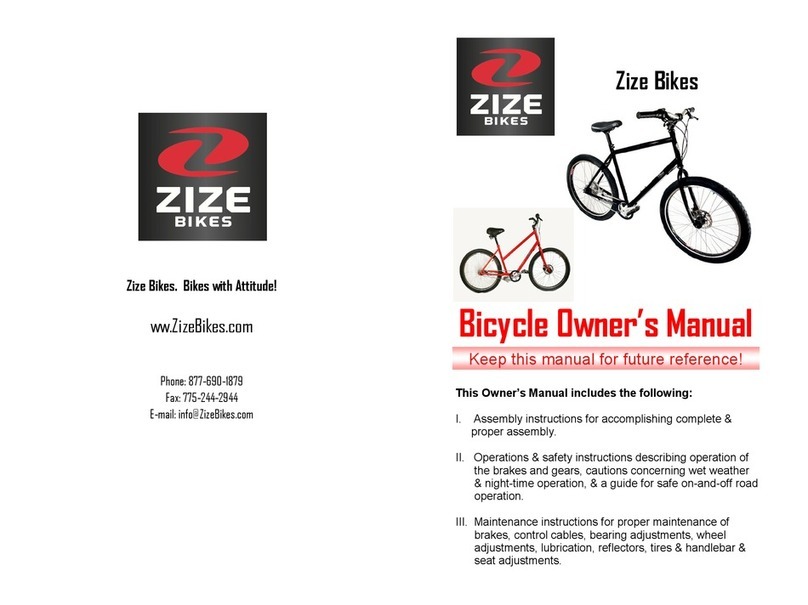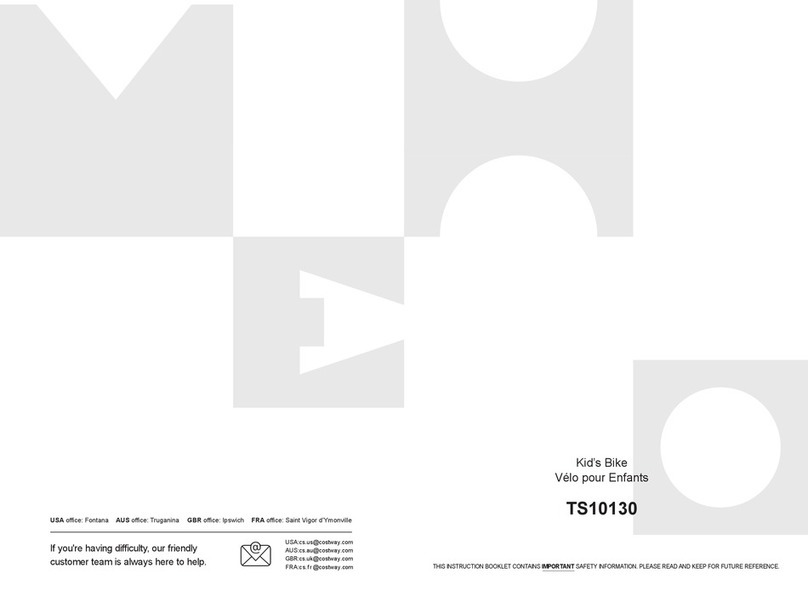Rose electronics CPTL User manual

V2019.03 CPTL_EN
OWNER'S MANUAL

1 Frame 10 Belt
2 Saddle 11 Crank with belt pulley and bottom bracket
3 Seat post 12 Handlebar/stem unit
4 Saddle clamp 13 Light
5 Rear rack 14 Fork
6 Mudguard 15 Hub
7 Rear light 16 Spoke
8 Frame splitter 17 Rim
9 Brake caliper 18 Tyre
1
2
6
12
14
3
7
13
9
4
11
6
15
16
17
18
5
8
9
10

Congratulations on the purchase of your ROSE dream bike!
We are pleased that you have decided to buy a ROSE bike and are sure that your new bike will put a smile on your face
every day.
Your bike is unique – before it has found its way to your home, this bike was individually assembled by hand by a
skilled mechanic and carefully inspected by another specialist to ensure it meets our highest quality standards. We thus
guarantee that your bike offers reliability and state-of-the-art technology. Easy-to-use gears and brakes, an excellent
design and great value for money are just some of the reasons why you will love your bike.
Some components were removed or adjusted for shipping. However, they can be easily re-assembled or re-adjusted in
just a few simple steps (see “3. Bike assembly“ on page 11).
Regular care and maintenance (see “7. Maintenance“ on page 21) will prolong the life of your beloved bicycle. This
manual includes all information on handling, maintenance and care you need to properly care for your bike.
We recommend you to carefully check and service your bike at regular intervals. Your safety and a long life of your bike
should be worth the effort.
This manual describes all details you need for a safe use of your bike, as well as the most important and general facts
about your bike. For more detailed information on single bike components, please see the respective owner’s manual
of the manufacturer. All manuals are included in the purchase documents of your bike or available online.
Please take the time to read this manual carefully. The sections marked with the signal words “DANGER“ and
“WARNING“ are of particularly high importance. The instructions contained in these warnings must be followed.
Moreover, we recommend you to follow the steps described in “5. Before and after your ride“ on page 16 and to
have your bike serviced regularly (see “7. Maintenance“ on page 21) to ensure your safety on every ride.
Have fun with your dream bike! Your ROSE Bikes team

1. General information ................................................................................................................ 5
1.1 Explanation of symbols used ......................................................................................................5
1.2 Target group.....................................................................................................................................6
1.3 Requirements to operate a bike.................................................................................................6
1.4 Owner’s manuals supplied by component manufacturers ...............................................6
1.5 Tools....................................................................................................................................................6
1.6 The special properties of carbon...............................................................................................6
1.7 Installation of components and accessories..........................................................................6
1.8 Warranty and guarantee...............................................................................................................6
1.9 Wearing parts...................................................................................................................................7
1.10 Weight limit.......................................................................................................................................7
1.11 Exclusion of liability .......................................................................................................................7
2. Safety ........................................................................................................................................ 8
2.1 General safety..................................................................................................................................8
2.2 Safe use of a pannier rack...........................................................................................................9
2.3 The rider’s duty of care.................................................................................................................9
2.4 Intended use .....................................................................................................................................10
3. Bike assembly.......................................................................................................................... 11
3.1 Required tools..................................................................................................................................11
3.2 Opening the ROSE bike box and unpacking the contents ..................................................11
3.3 Straightening the handlebar and adjusting the steering play..........................................12
3.4 How to set your saddle height....................................................................................................13
3.5 Installing the pedals.......................................................................................................................14
4. Getting started for your first ride and getting used to your new bike .............................. 15
5. Before and after your ride...................................................................................................... 16
5.1 Before your ride ..............................................................................................................................16
5.2 After your ride..................................................................................................................................17
5.3 After a crash.....................................................................................................................................18
6. Bike transport and storage .................................................................................................... 19
6.1 Transport by car..............................................................................................................................19
6.2 Transport on a hitch or roof rack ..............................................................................................19
6.3 Bike storage......................................................................................................................................19
6.4 Bike shipping....................................................................................................................................20
7. Maintenance ............................................................................................................................. 21
7.1 Bike servicing...................................................................................................................................21
7.2 Drive belt maintenance.................................................................................................................22
7.3 Belt tension adjustment................................................................................................................22
7.4 Rear wheel installation and removal........................................................................................23
7.5 Drive belt replacement..................................................................................................................25
7.6 Headset play adjustment..............................................................................................................26
7.7 Tyre pressure...................................................................................................................................27

5
1. General information
This manual is the most important element to prevent any damages and risks during the assembly, use and servicing of
your new bike. It is provided to give you the most important technical information on your bike, to support you during
bike assembly and to give you helpful tips over the entire life of your bicycle. If in doubt about maintenance works,
please consult a qualified bicycle mechanic.
Please read this manual carefully before taking the first ride on your new bike and make sure you understand
everything. Ensure that third-party users are also informed about the contents of this manual and that they understand
and follow all instructions.
Keep this manual for future reference. If you sell or give away your bike, please also include the owner’s manual.
This manual is additionally available as a pdf file on rosebikes.com/manuals.
1.1 Explanation of symbols used
DANGER
…indicates a hazard with a high level of risk which, if not avoided, will result in death or serious injury.
WARNING
…indicates a hazard with a medium level of risk which, if not avoided, may result in minor or moderate injury.
CAUTION
…indicates a hazard with a low level of risk which, if not avoided, may result in minor or moderate injury.
NOTE
…indicates a potentially hazardous situation that may result in damage to property.
…indicates additional information.

6
1.2 Target group
This manual is intended for you, the owner of the ROSE CPTL.
Assembly and maintenance works require basic knowledge in bicycle technology. If in doubt, please consult a qualified
bicycle mechanic. Improper assembly or maintenance of your bike may result in serious injury or death!
1.3 Requirements to operate a bike
The rider should be able to ride a bike, this means that he/she must have basic cycling skills and sufficient balance
to safely ride and steer a bicycle. The use on public roads requires a high level of cognitive ability. The rider must be
mentally and physically able to safely operate the bicycle over a longer period of time and longer distances.
For newcomers and those getting back into cycling after a long time special cycling skills courses are recommended.
1.4 Owner’s manuals supplied by component manufacturers
This manual contains all information you need for a safe use of your bike. However, apart from this manual, the
documents supplied with your bike also include some product information or manuals of different component
manufacturers. If need be, you can use those documents for further information on the respective product, its
assembly and setup. The owner’s manuals of some manufacturers might only be available online.
1.5 Tools
All works on your bicycle require appropriate tools.
All nuts and bolts must be tightened with an appropriate torque wrench. Proper use prevents overtightening and
breaking of the bolts.
A proper installation and removal of components can only be guaranteed when using perfectly functioning and
undamaged tools.
1.6 The special properties of carbon
Carbon parts are very sensitive to pressure. Carbon frames must not be clamped (e.g. into a workstand) or subjected to
pressure in any other way. Always tighten carbon parts to the prescribed torque.
After a fall, damages to carbon components might not show up immediately. If in doubt, please consult a qualified
bicycle mechanic.
Carbon parts have a limited lifespan. Handlebars, seat posts, stems, cranks and wheels made from carbon should be
replaced regularly (e.g. every three years). We recommend to replace ROSE frames and forks made from carbon every
six years.
Heat permanently damages the carbon structure. Carbon parts must not be stored close to heat sources or in a vehicle
in direct sunlight.
UD carbon frames may have a blotchy and uneven surface structure. This is what characterizes the UD look. This is no
defect or fault.
1.7 Installation of components and accessories
Bicycle trailers must only be fixed to the rear axle of the bike using special hitching devices.
Child seats and trailers for clamp mounting on seat post or frame must not be used.
Racks must only be attached to special fixing points designed for this purpose.
Please read the manufacturers’ manual before the installation of components and accessories.
Make sure to not exceed the maximum system weight (see “1.10 Weight limit“ on page 7) even with all add-on parts
and accessories fitted!
Bigger pannier bags like e.g. Ortlieb Back Roller panniers won’t fit, as they interfere with the feet. Recommended
panniers: Ortlieb Sport Roller Plus (ROSE product code: 2089764).
1.8 Warranty and guarantee
For all information on warranty and guarantee see rosebikes.com/termsandconditions.

7
1.9 Wearing parts
As a technical product, a bicycle consists of many components which are all subject to wear given the nature of their
function. Therefore, the components listed below should be checked regularly and replaced, if necessary:
• Tyres and tubes
• Rims
• Brake pads
• Bearings (headset, bottom bracket, hub bearings)
• Belt and sprockets
• Handlebar and stem
• Grips
• Saddle and seat post
• Grease, lubricant, hydraulic oil and brake fluid
• Inner and outer brake and gear cables
• Stickers and paintwork
1.10 Weight limit
The ROSE CPTL is designed for a maximum weight of 130 kg. The maximum weight is derived from the weight of the
cyclist, bicycle, gear (helmet, backpack, shoes, clothes) and luggage.
1.11 Exclusion of liability
The tasks described in this manual require special knowledge and should only be carried out by people with sufficient
expertise.
The user is liable for damages resulting from:
• Misuse or any other cause beyond the range of the intended use (see “2.4 Intended use“ on page 10)
• Non-compliance with safety regulations
• Improper assembly, repair and maintenance
• Use of unapproved replacement parts and accessories
• Change of construction
If in doubt, please consult the ROSE service or a qualified bicycle mechanic.

8
2. Safety
2.1 General safety
DANGER
Risk of injury due to insufficient protective equipment!
Effective safety equipment contributes to your personal safety.
• Always wear a helmet.
• Always wear highly visible and reflective clothing.
DANGER
Risk of accident due to improperly installed components!
Improperly installed components may loosen during the ride!
• Always follow the installation instructions included in this manual.
• If in doubt, please consult the ROSE service or a qualified bicycle mechanic.
DANGER
Risk of accident due to insufficient equipment for use on public roads!
The CPTL Speed model is not intended for use on public roads. If you want to ride your bike on public roads
nevertheless, you should consult a qualified bicycle mechanic to retrofit all components required according to
national road traffic regulations (lighting system, reflectors etc.).
DANGER
Risk of accident due to reduced braking performance caused by brake pads that are not broken in!
Disc brakes can only achieve full braking power when the brake pads are broken in. Choose a place off public roads
to break in the pads.
• Brake 20 to 30 times with the front or rear brake from a speed of 30 km/h down to 5 km/h and repeat the
process for the second brake. You should brake as hard as possible without locking one of the wheels.
DANGER
Risk of accident due to sudden total failure of pre-damaged or worn components!
Bicycles are subject to high stress and wear. A fall or unforeseeable manoeuvres cause unpredictable peak loads.
These loads can pre-damage components of your bike.
• You should have your bike checked for wear and damages by a qualified bicycle mechanic regularly. Also see
“7. Maintenance“ on page 21. Worn or damaged components must be replaced.

9
2.2 Safe use of a pannier rack
WARNING
Improper handling of a pannier rack may cause you to fall!
Improper handling of a pannier rack or the luggage attached to it may lead to serious crashes.
• The rear rack can take a load of up to 8 kg per side.
• Make sure to not exceed the bicycle’s maximum load capacity of 130 kg, even when the rack is loaded.
• You should only use appropriate pannier bags. Also see “1.7 Installation of components and accessories“ on page 6.
• A loaded rack may change the steering and braking characteristics of your bike.
• Ensure lights or reflectors are not obstructed when the pannier is attached.
• Distribute weight evenly on both sides of the rack.
• Secure luggage against sliding or falling down. Make sure there are no loose parts hanging down.
• Secure and regularly check the rack’s mounting brackets.
• Racks must not be modified.
• Do not attach any bike trailers or child seats to the rack.
2.3 The rider’s duty of care
Following the instructions specified in this manual does not absolve the riders from their duty of care to ensure that
their bike is always in good condition. If there are any questions, please consult a qualified bicycle mechanic or the
ROSE Service.

10
2.4 Intended use
The intended use of ROSE bikes is divided into five different categories – ranging from the use on paved roads through
to downhill or freeride use. The bikes must only be used in accordance with their intended purpose/use. Otherwise, the
user takes responsibility.
A sticker on the frame of your bike will show you the intended use.
1
Category 1: For use on paved roads only
Category 1 includes all bikes and components that should only be used on paved roads.
The wheels are always in contact with the ground.
2
Category 2: For use on and off the road and for drops of up to 15 cm
Category 2 includes all bikes and components that can be used in conditions described under
category 1, as well as on gravel roads and moderate trails. The wheels may also loose contact
with the ground. Drops should not be higher than 15 cm.
3
Category 3: For use in rough terrain and for jumps of up to 61 cm
Category 3 includes all bikes and components that can be used in conditions described under
category 1 and 2, as well as on rough trails and rough and unpaved roads that require good
cycling skills. Jumps and drops should not be higher than 61 cm.
4
Category 4: For use in rough terrain and for jumps of up to 122 cm
Category 4 includes all bikes and components that can be used in conditions described under
category 1, 2 and 3, as well as for higher speeds on rough and steep trails. Jumps should not be
higher than 122 cm.
5
Category 5: Extreme biking (Downhill, Freeride, Dirt)
Category 5 includes all bikes and components that can be used in conditions described under
category 1, 2, 3 and 4, as well as for extreme jumps and high-speed riding on rough trails and in
bike parks.
Dirt and slopestyle bikes are not designed for downhill riding. For high drops or jumps with flat or
rough landings, you need a long-travel bike (freeride or downhill bikes). Dirt bikes are designed for
dirt jumping and for use in skateparks or on pump tracks. The riders should always use protective
clothing and armour like a helmet/full face helmet, knee pads, elbow guards, back protectors and
gloves.
When using your bike regularly in conditions described under category 5, you should check and
replace the most stressed components more often.

11
3. Bike assembly
This chapter aims at helping you remove your bike from the ROSE bike box and re-assemble it.
Depending on the bike model, different components may have been removed or repositioned for shipping. In addition,
you have to fit the pedals and check whether your bike is in a roadworthy condition.
DANGER
Improperly installed components can cause serious crashes!
Improperly installed components may loosen during the ride!
• Always follow the installation instructions included in this manual.
• If in doubt, please consult the ROSE service or a qualified bicycle mechanic.
3.1 Required tools
Depending on bike model and equipment, you will need the following tools for assembly:
• 4 mm, 5 mm, 6 mm, 8 mm hex wrench
• Torque wrench with a 4 mm, 5 mm, 6 mm and 8 mm hex drive
• 15 mm open-ended spanner
3.2 Opening the ROSE bike box and unpacking the contents
Before opening, check the ROSE bike box for any damages. After that, check the contents for completeness! Please
notify all possible defects immediately!
1. Carefully open the ROSE bike box. Make sure not to damage any parts especially when using a knife.
2. Carefully unpack the contents.
3. Remove – if present – any transport locking devices from the frame.
Keep hold of the ROSE bike box! You might need it to return the bike for servicing or repair.

12
3.3 Straightening the handlebar and adjusting the steering play
CAUTION
The adjusting bolt for the steering play (1) does not serve to tighten the stem, but only to adjust the play in the
steering bearing!
1. Loosen the stem clamp bolts (2) with a 4mm hex wrench. Do not loosen the adjusting bolt for the steering play (1).
2. Turn the handlebar through 90 degrees and align it with the front wheel.
3. Check the steering bearing for play by pulling the front brake and trying to push the bike gently backwards and
forwards.
→There must be no play.
4. If you feel any movement inside the headset, tighten the adjusting screw for the steering play (1) a quarter turn.
5. Check the headset once again for play and repeat the previous steps, if need be, until there is no more play inside
the bearing.
If in doubt, seek professional advice from a qualified bicycle mechanic.
6. Tighten the stem clamp bolts (2) alternately to a torque of 6Nm.
7. Loosen the handlebar clamp bolt (3) with a 4mm hex wrench.
8. Adjust the angle of the handlebar.
9. Tighten the clamp bolts to a torque of 6 Nm.
1
26 Nm
6 Nm
3

13
3.4 How to set your saddle height
DANGER
Risk of accident and damage due to the extension of the seat post beyond the minimum insertion mark!
If the seat post is not inserted to the minimum insertion mark, it may break or damage the frame while riding.
• The seat post must not be extended further than the limit mark.
1. Slide up the cover of the saddle clamp.
2. Use a 4mm hex wrench to loosen the seat clamp.
3. Change the height of the saddle by sliding the seat post up or down and make sure the saddle is straight.
→The seatpost comes with a minimum insertion line marked on it. Make sure that this line is not visible after
adjusting the saddle height!
4. Tighten the bolt of the seat clamp to a torque of 6 Nm.
5. Slide the cover of the saddle clamp back over the clamp.
6. Get on your bike and check whether the saddle height is right.
→It should be safe to get on and off the bike.
→Make sure your toes can touch the ground when standing still.
6 Nm

14
3.5 Installing the pedals
One of the pedals has a right- and the other a left-hand thread.
Most pedals have the letter “L” and “R” stamped on the end of the thread. Some pedals come with a groove in
the flange of the left pedal.
For more information see the manufacturer‘s manual.
1. Check if your bike was supplied with washers and slide both
washers onto the pedal axles – if present.
2. Turn the left pedal counter-clockwise to screw it into the
thread of the left crank arm and tighten the pedal to a torque
of 35Nm.
35 Nm
3. Turn the right pedal clockwise to screw it into the thread of the
right crank arm and tighten the pedal to a torque of 35Nm.
35 Nm

15
4. Getting started for your first ride and getting used to your new bike
Make yourself familiar with the handling, brakes and shifting system of your bike away from public roads. Do not forget
to wear a helmet! Only slowly increase the difficulty of the terrain or manoeuvres.
Requirements:
• The bike is assembled in accordance with chapter “Bike assembly” (see “3. Bike assembly“ on page 11).
• The saddle height is properly adjusted to guarantee a comfortable ride and to ensure you will get on and off the
bike easily (see “3.4 How to set your saddle height“ on page 13).
• All tasks from chart “Before your ride” (see “5. Before and after your ride“ on page 16) have been carried out.
1. Break in the brake pads.
Choose a road away from public roads and brake 20 to 30 with the front or rear brake from a speed of 30 km/h
down to 5 km/h. You should brake as hard as possible without locking one of the wheels. Repeat the process for
the other brake. Only then the brake can show its full braking power.
Please see the brake manufacturer’s instructions for more information (see enclosed manual).
2. Check the functioning of the brakes while riding.
Normally, the rear brake is located on the right-hand side of the handlebar, and the front brake is on the left-
hand side. However, if required, the brake levers can also be mounted the other way around.
If the positioning of the brake levers on your bike is new and unfamiliar, you will have to be careful on your
first rides. Make yourself familiar with the functioning and power of the brakes while riding at reduced speed.
Many brakes offer the possibility to adjust bite point and lever reach. Please see the brake manufacturer’s
instructions for more information (see enclosed manual).
Clipless pedals:
3. Start practicing getting in and out of the pedals with one foot on the ground or when leaned against a wall. Only
practice clipping in and out while riding after you have safely mastered the procedure while standing.
The release tension of the engagement system is adjustable. Please see the pedal manufacturer’s instructions for
more information (see enclosed manual).
Shifting system:
4. Shift through all gears while riding at reduced speed and choose the right gear.
→You can shift into all gears.

16
5. Before and after your ride
5.1 Before your ride
To make sure your bike is safe to ride, you should carry out certain tasks before your ride. This is for your own safety in
particular, yet also for your riding pleasure. Nothing is more annoying than having a defect on a bike tour.
If there are any defects or flaws, you should have your bike inspected and repaired by a qualified bicycle mechanic.
Never ride with a defective bicycle!
Task/Check
Before your first ride
Before every ride
Wheels
Check that the wheels are straight. Lift the wheels one after the other and spin them.
→The wheels must spin smoothly.
→The wheels must run true, without moving up and down or from side to side.
→The tyres must not rub against the frame.
X X
Check the wheels for play in the hubs. Lift the wheels one after the other and move the wheels to
the side.
→There must be no play.
X X
Check the freehub mechanism of the rear hub to ensure proper engagement:
Sit down on your bike, pull the front brake and pedal with moderate force when standing.
→The power must be transferred to the rear wheel.
→The freehub must not slip.
X X
Check the tyre pressure:
The best way to check the pressure of the tyres is to use a floor pump with a pressure gauge.
→The tyre pressure must not fall below or exceed the minimum or maximum value (see “7.7 Tyre
pressure“ on page 27).
X X
Check the tyres for damages and wear.
→There must be no damages.
→The tyres must not be worn so that the puncture protection belt or the carcass threads can be
seen through the tread.
X X
Check whether the quick-release skewers and thru axles are properly attached. X X
Brakes
Check the bite point of the brakes: Pull one brake lever after the other while standing.
→The bite point must be felt around half way down the brake lever travel.
X X
Check the braking performance: Pull one brake lever after the other while standing and push the bike
backwards and forwards.
→The front and rear wheel must lock when the brake lever is pulled.
X X
Check the brake pads for wear.
→The brake pad on the metal backing plate must be at least 0.5mm thick. X
Check the disc rotor for wear.
→Minimum thickness of brake rotors: Avid:1.55mm, Magura:1.8mm, Shimano:1.5mm. X
Check whether the brake hoses and connections are losing brake fluid and check them for defects.
→Brake fluid must not escape at the connections. X X

17
Parts
Verify the tight fit of the stem: Stand in front of the bike with the front wheel between your knees and
try to turn the handlebar left and right.
→It should not be possible to turn the handlebar with normal force.
X X
Check the headset for play: Stand next to your bike with both hands on the handlebar. Pull the front
brake lever and gently push the bike backwards and forwards.
→There should be no play in the headset.
X X
Verify the tight fit of the seat post: Stand behind your bike, hold the saddle with one hand and try to
turn it left and right.
→It should not be possible to turn the saddle or seat post.
X X
Make sure that all parts are tight.
→Tighten the parts to the proper torque, if need be.
X X
Frame
Check the frame for damages and deformation.
→There must be no damages. X X
Check whether all cables and hoses are in the cable clips and verify the tight fit of the clips.
→All cables must fit firmly in the cable clips. X X
5.2 After your ride
DANGER
Brake failure or reduced braking power due to dirty brake pads or disc rotors!
Brake pads and disc rotors must be free from lubricating substances such as grease, oil (also skin oil), wax, silicone etc.!
Brake pads or disc rotors contaminated in this way must no longer be used!
5.2.1 Cleaning your bike
After your ride, you should clean your bike thoroughly using a soft cloth and clear water. Never use a high pressure
washer!
Stubborn dirt can be removed with a gentle cleaning agent. In this case, it is best to use washing up liquids for
domestic needs. Pay attention to the notes and recommendations for use printed on the respective cleaner. In addition,
you will find numerous cleaning and care products for your bike on www.rosebikes.com.
5.2.2 Belt drive maintenance
Clean the belt and both pulleys after every ride:
• Remove coarse dirt with a soft brush and clear water. Remaining dirt can be removed with a gentle cleaning agent.
• Make sure there are no small stones, branches or other things between belt and pulleys.
A thin layer of dry silicone spray applied on the toothed side of the belt helps prevent squeaking noises.
5.2.3 Parking your bike
Bicycles should always be protected against falling down. Especially for lightweight bikes, it is often enough to fall down
from a standing position to permanently damage frame or components. Please also see ”Bike transport and storage“.

18
5.3 After a crash
DANGER
Damaged or broken components can cause serious crashes!
Crashes or exceptional stresses may cause unnoticed and invisible damages.
• Riding with damaged, bent or even torn parts is extremely dangerous.
• After a fall, the bike and its components must be checked by the ROSE service or by a qualified bicycle
mechanic.
• Never fix bent parts yourself, but replace them for your own safety.
It is very hard to assess the level of damage of a carbon part. Damages cannot necessarily be seen from the outside. A
scratch on the surface can indicate a delamination (a separation of the single carbon layers).
Especially for lightweight bikes, it is often enough to fall down from a standing position to permanently damage
frame or components. When suspecting a damage, you should always consult the ROSE service or a qualified bicycle
mechanic.
Damages on aluminium parts are indicated by dents, cracks, deformations or discolorations. If you notice any sign of
damage, the component or bike must no longer be used. When suspecting a damage, you should always consult the
ROSE service or a qualified bicycle mechanic.

19
6. Bike transport and storage
6.1 Transport by car
The best and safest way to transport your bike is by car. Here, your bike is perfectly protected from the elements and
from theft. Yet there are some things you should bear in mind:
• When exposed to direct sunlight, surfaces can get very hot inside a car. Carbon parts must be covered or
protected from direct sunlight.
• Carbon parts are extremely sensitive to pressure. When stacking up parts, e.g. putting wheels onto a frame, the
parts must be well padded. Many manufacturers offer special wheel bags for their wheels. In this way, the wheels
are perfectly protected during transport.
• When removing the wheels, make sure to fit a protective spacer between the dropouts of frame or fork.
6.2 Transport on a hitch or roof rack
Rear bike racks with clamps for top, down or seat tube are not suitable for carbon frames. The clamping force of the
clamps may damage the carbon structure.
Rims must be padded before fitting lashing straps or ratchet systems.
When transporting several bikes on one hitch or roof rack, please make sure that there is sufficient space or padding
between the bikes.
If you want to transport bikes with carbon wheels on a hitch rack, please make sure that there is enough distance
between the exhaust pipe and the wheel. The minimum distance is 45 cm behind the exhaust pipe and at least
20cm on top.
Child seats must be removed before transport.
Please also note the instructions of the bike rack manufacturer.
6.3 Bike storage
You should park your bike using an appropriate cycle stand which ideally only holds the rear wheel. Make sure to
check the tyre pressure when the bike has stood for a long time. You should not park your bike for longer with no air
in the tyres.
Another alternative for the secure storage of your bike is to hang it onto a hook that is padded or covered with plastic
or rubber. Only bikes with deep-section rims made from carbon must not be stored in this way.
If you use a tubeless system, you should remove the sealant from the tyre when parking your bike longer than three
months. Some sealants contain ingredients that increase corrosion and could thus damage the rim.

20
6.4 Bike shipping
Depending on the size of the ROSE bike box, the bike is shipped in different conditions. Ship your bike in the same
condition you’ve received it.
1. Secure or cover all loose or moving parts properly. Sharp or pointed components should be wrapped additionally to
make sure they won’t damage other parts of your bike and won’t tear through the outer packaging.
2. If your bike was delivered with a removed front wheel, the front wheel should also be removed for shipping now.
Wrap the front wheel with a cardboard which will also protect the handlebar and top tube of your bike.
3. If the wheels need to be removed, you must thread the thru axles into the dropouts.
4. Position the cardboard box at the rear on the side of the rear derailleur.
5. Protect the top tube from damages through the handlebar by using appropriate material (e.g. foam tubing).
Table of contents
Other Rose electronics Bicycle manuals
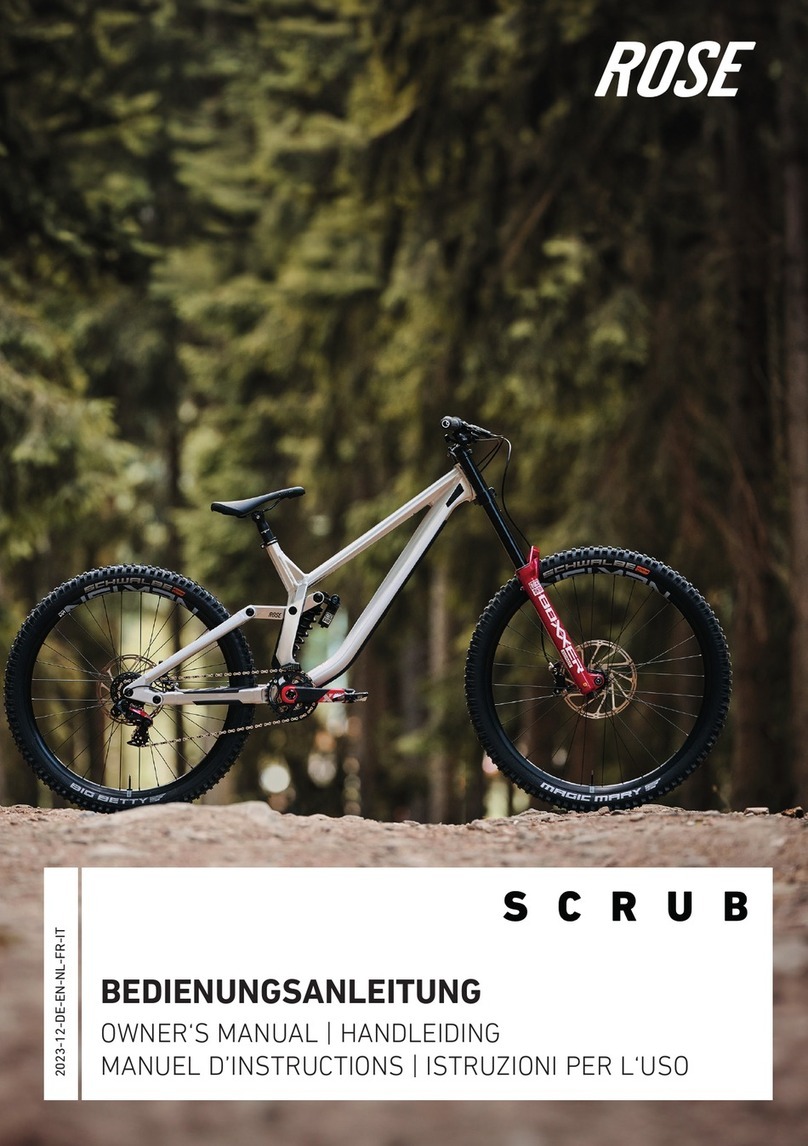
Rose electronics
Rose electronics SCRUB User manual
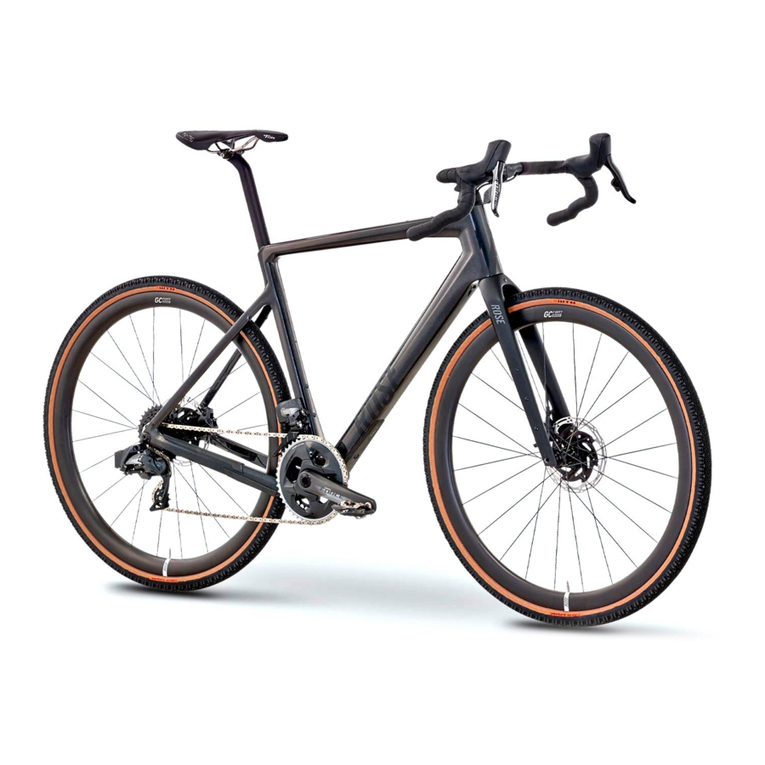
Rose electronics
Rose electronics BACKROAD+ User manual
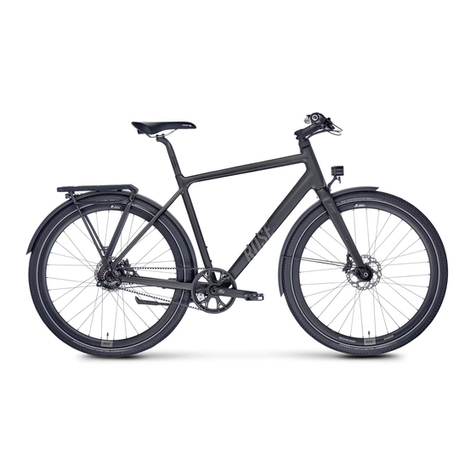
Rose electronics
Rose electronics Black Lava User manual
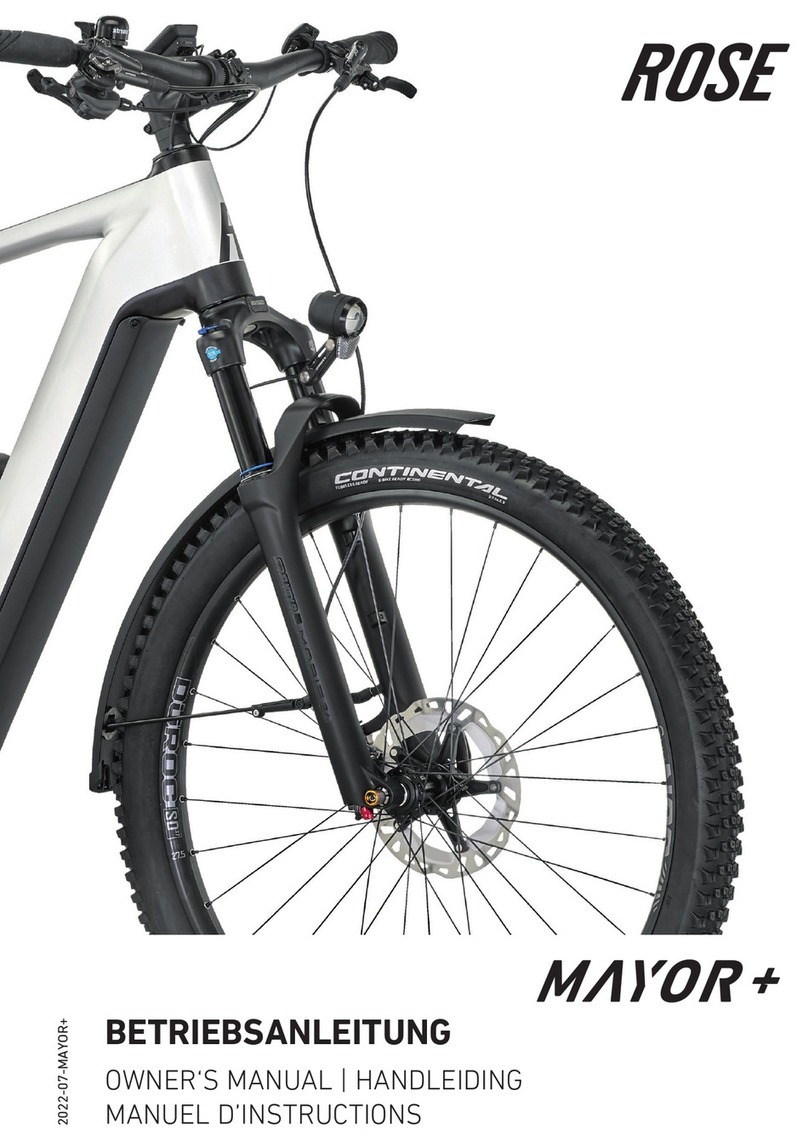
Rose electronics
Rose electronics MAYOR + User manual
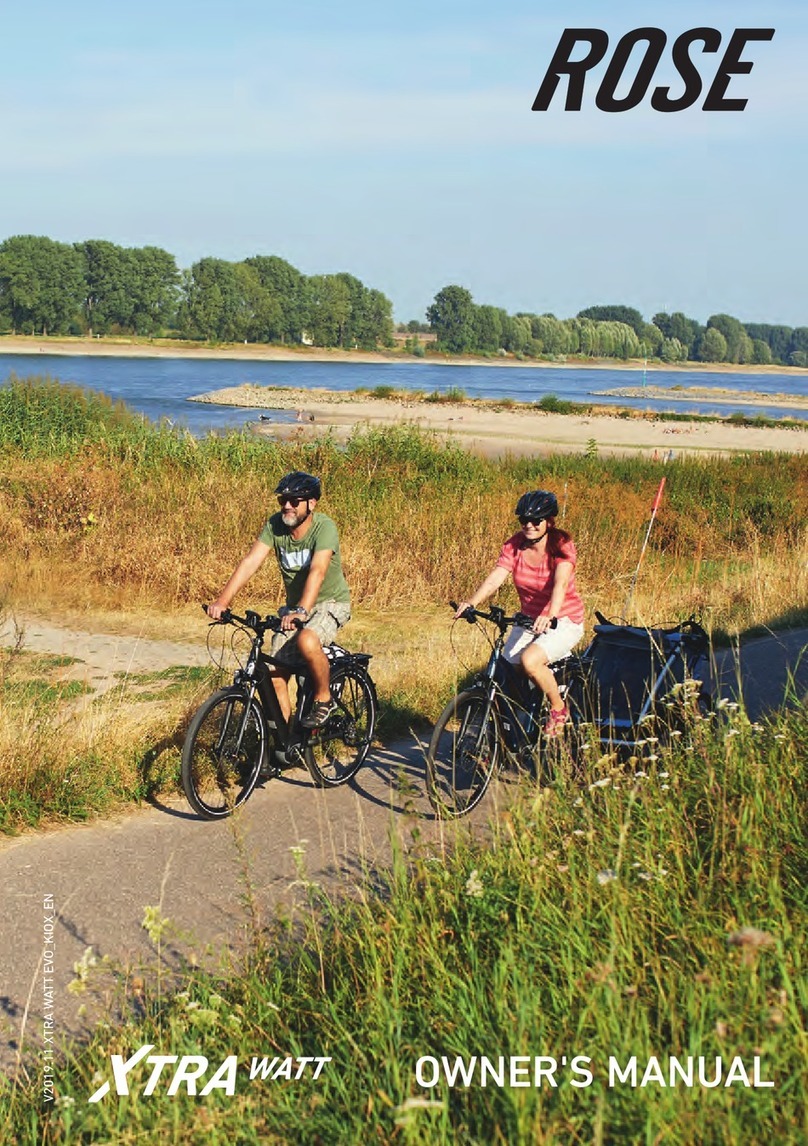
Rose electronics
Rose electronics Xtra Watt 2019 User manual

Rose electronics
Rose electronics BACKROAD User manual
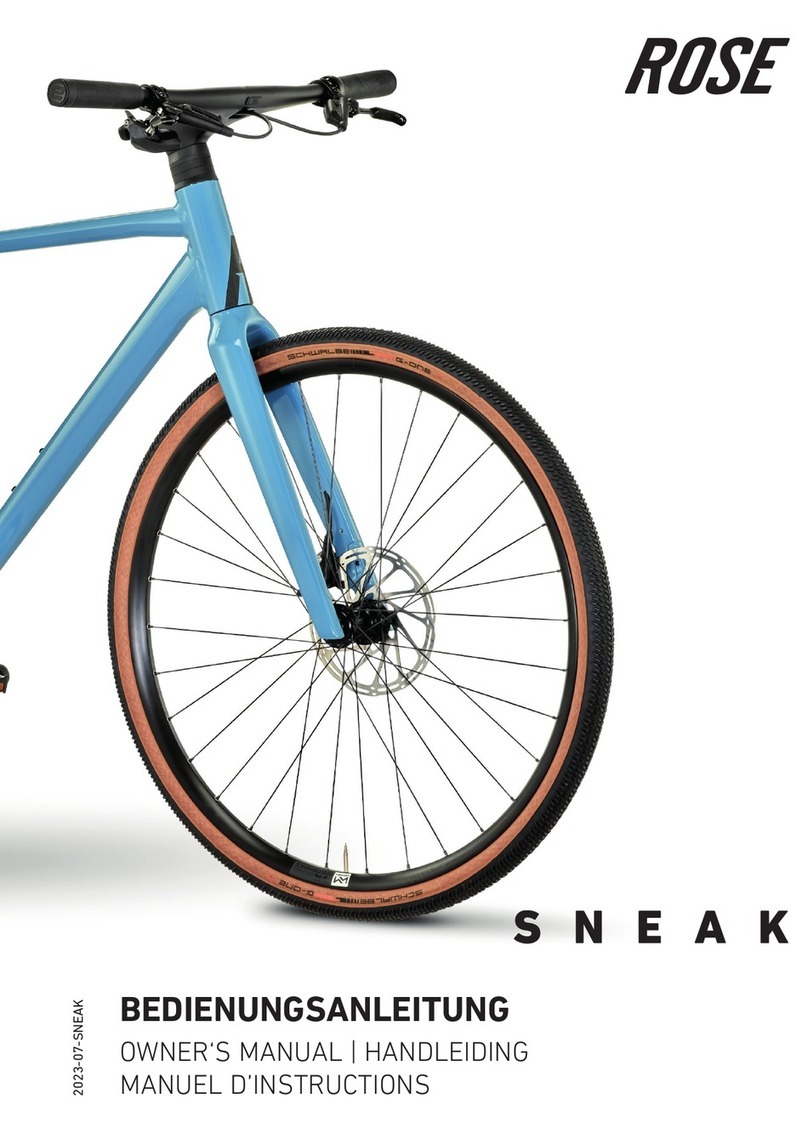
Rose electronics
Rose electronics SNEAK User manual
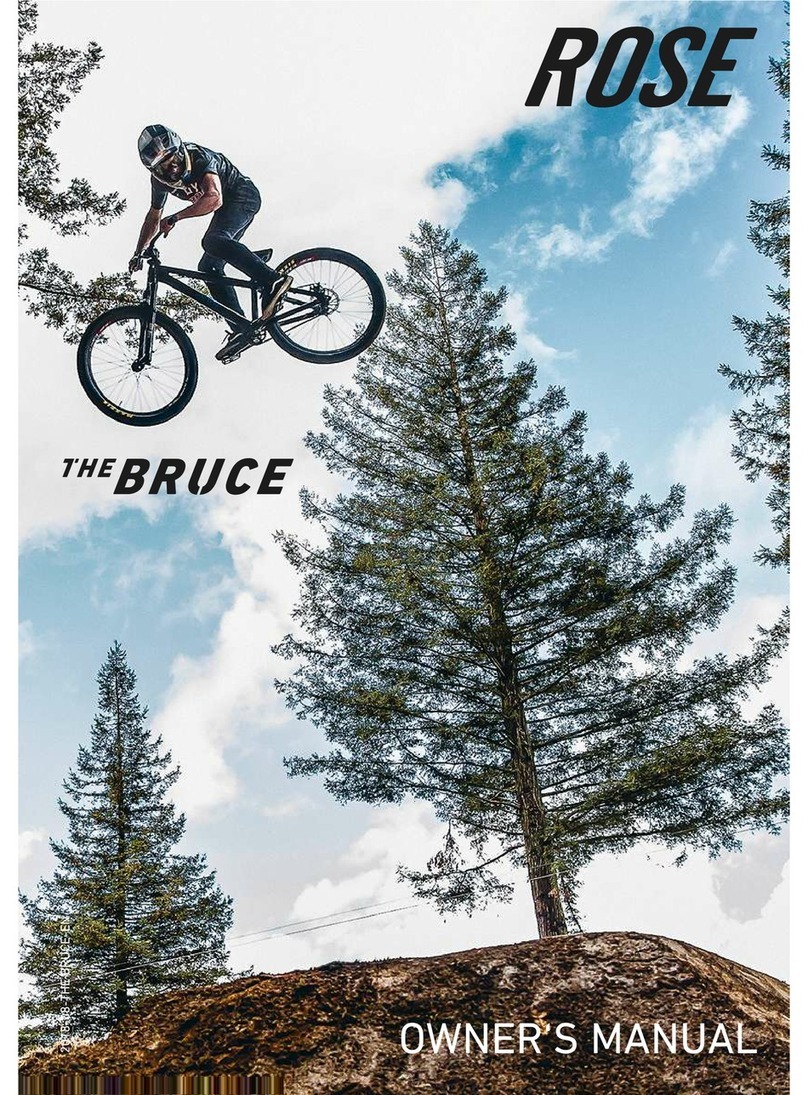
Rose electronics
Rose electronics The Bruce User manual

Rose electronics
Rose electronics MULTI SPORT User manual

Rose electronics
Rose electronics BONERO User manual

